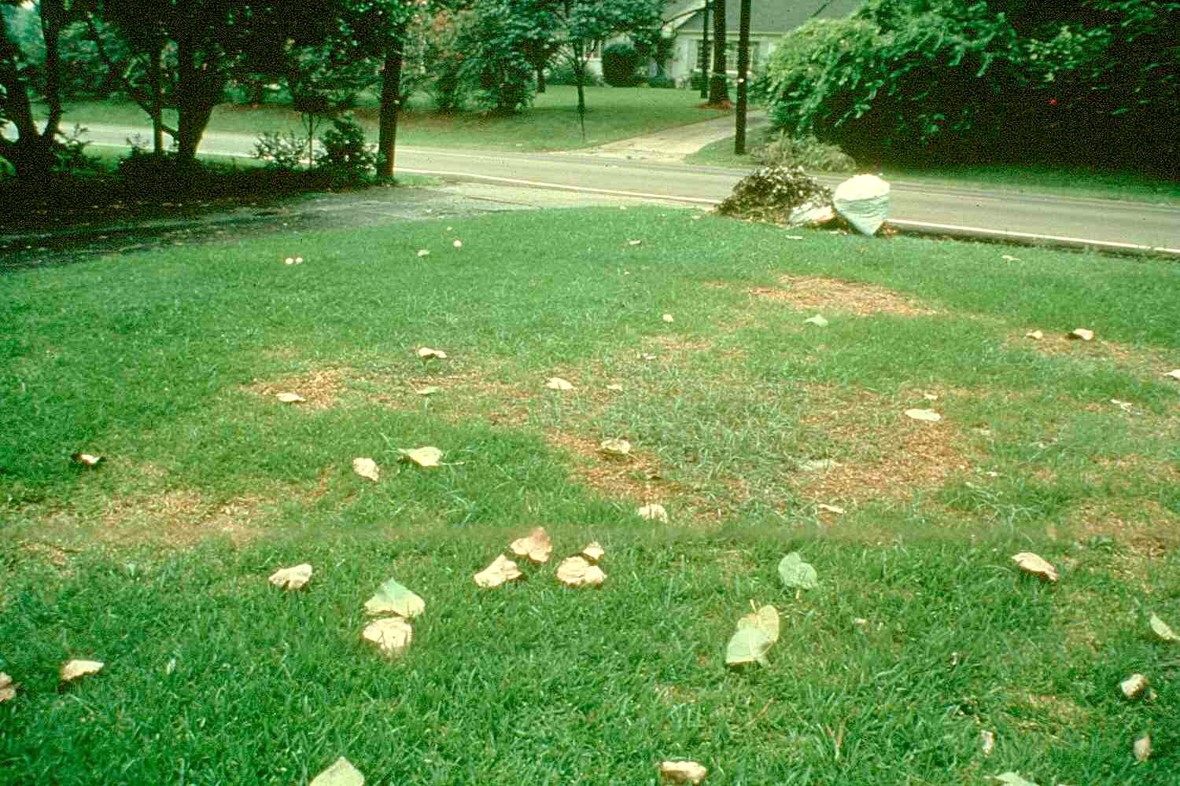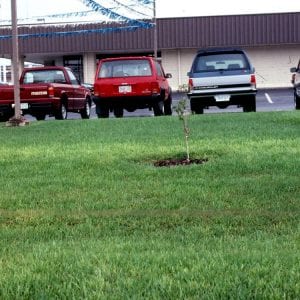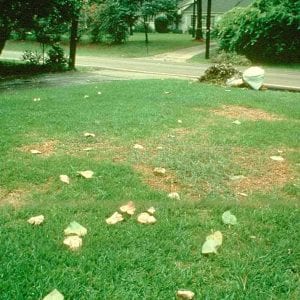Lawn & Garden

Take-all root is a destructive disease of St. Augustinegrass. Disease outbreaks, occur in Alabama wherever well-managed St. Augustinegrass lawns and sod fields are found. All St. Augustinegrass cultivars are susceptible to take-all root rot.
Frequent, heavy spring and summer rains may contribute to damaging disease outbreaks. Take-all development may also be favored by heavy liming, use of nitrate nitrogen-containing fertilizers, and deficiencies of certain micronutrients.
The soil-inhabiting fungus Gaeumannomyces graminis var. graminis is the causal agent of take-all root rot on St. Augustinegrass. This fungus may also be responsible for an undescribed patch disease of centipedegrass.
Symptoms
The first symptoms of take-all root rot usually appear in the spring and summer as yellowing (chlorosis) of the leaves, which gives the affected areas of the lawn a yellow-green cast (figure 1). Yellowing of the turf canopy can, however, indicate other problems such as chinch bug damage, certain nutrient deficiencies, or drought stress. Folding of the leaves along the midrib, another symptom of drought stress, may also be seen at early stages of the disease. Later, severe thinning of the turf in circular to irregular patches ranging from 3 to more than 15 feet in diameter occurs as the infected stolons die (figure 2). If all the grass dies, ugly patches of bare ground are often invaded by grassy and broadleaf weeds. Heaviest damage occurs on sunny sites; symptoms often are less severe on turf under heavy shade. Patches of declining or dying turf often persist from one year to the next.
- Figure 1. Irregular patches of yellowed or chlorotic turf are early symptoms of take-all patch on St. Augustinegrass.
- Figure 2.. Take-all patch on St. Augustinegrass with grassy weeds infiltrating the dying patches of turf.
Take-all root rot and brown patch, which can have similar field symptoms, are easily confused. On brown patch–damaged turf, leaf sheaths and leaves are rotted, but the roots and stolons are often unharmed. On take-all–damaged St. Augustinegrass, the leaves and leaf sheaths are not damaged; the roots are usually dark brown to black in color and often badly rotted. Few healthy white roots are seen on the infected stolons.
Rotted roots are so brittle that the stolons can easily be pulled from the ground. Blackening of the nodes and stolons may also be seen. With the aid of a good hand lens, numerous tiny, gray, lobed hyphopodia, which definitively identify the causal fungus, can be seen on the underside of the infected stolons.
St. Augustinegrass sod fields damaged by take-all usually exhibit the same yellowing of the foliage often associated with iron deficiency. Instead of patches of yellow turf, the entire sod field may be off-color. Although the typical turf dieback is rarely seen in sod fields, damaged St. Augustinegrass sod often fails to knit properly and may fall apart when lifted for harvesting.
Take-all root rot is not confined to any particular soil type. This disease occurs on soils ranging from fine sandy loams and sands of the Lower Coastal Plain to blackland prairie clays of the Blackbelt. St. Augustinegrass cultivars apparently have no resistance to take-all root rot.
Management Practices
Specific control strategies for take-all root rot have not been developed. However, based on experience with other patch diseases, some control recommendations are suggested. Turfgrass management practices, not chemicals, offer the best hope for managing this disease.
Nitrogen sources may affect the severity of St. Augustinegrass take-all root rot. On several turfgrasses and small grains, fertilizers containing nitrate nitrogen (ammonium nitrate and calcium nitrate) increased the severity of diseases caused by similar fungi, so their use should be avoided when possible. Although no association between the use of nitrate nitrogen and the development of take-all root rot has been shown, ammonium-containing fertilizers (such as ammonium sulfate, urea, and ammonium chloride) are the preferred nitrogen sources for well-managed St. Augustinegrass lawns and sod fields. Light monthly applications of nitrogen fertilizers or the use of a slow- release fertilizer to maintain moderate turf growth throughout the growing season is also recommended. Excessive nitrogen fertilization may contribute to disease development.
The development of take-all disease on wheat, which is caused by a related ectotrophic fungus, has been linked to a deficiency of the soil mineral manganese. Foliar applications of a micronutrient supplement containing manganese and other essential minerals may temporarily correct mineral deficiencies. Soil applications of manganese sulfate can be made to correct serious manganese deficiencies. However, most Alabama soils have sufficient manganese that may not be available to the turf. Using ammonium nitrogen and/or chloride- containing fertilizers will increase manganese availability to the plant. Muriate of potash is a good source of both chloride and potassium. For best results, apply nitrogen and potassium in a 2:1 ratio (apply 1 pound of actual potassium for every 2 pounds of actual nitrogen used).
Heavy liming has also been linked to increases in take-all and a reduction in the availability of manganese. Maintain soil at pH 5.5 to 6.0 on intensively managed St. Augustinegrass lawns. To reduce the risk of disease, apply no more than 10 to 20 pounds of lime per 1,000 square feet of turf per season. Use acid-forming fertilizers on sites with near-neutral to alkaline soils (pH 7.0+) to lower the soil pH. Topdressing with sphagnum peat moss has proven to aid in the recovery of take-all damaged St. Augustinegrass lawns. Evenly distribute 1 bale of sphagnum peat moss per 1000 feet2 of lawn.
Other management practices such as raising the cutting height for drought-stressed lawns, timely irrigation, and improving drainage in wet areas may also help control take-all on St. Augustinegrass. Raising the cutting height keeps the turf from being scalped and provides more leaf area to support the damaged root system.
Because recovery of take-all–damaged St. Augustinegrass is often poor, complete renovation of take-all–damaged lawns may be necessary. However, laying new St. Augustinegrass sod over areas where take-all has occurred is not advisable as new sod may succumb to take-all root rot. Centipedegrass may be the best replacement turf because few cases of take- all have been reported on this turfgrass.
With proper management and timely fungicide treatments, however, the risk of spring dead spot on both turfgrasses can be minimized. Also, fungicides are available that will control spring dead spot on bermudagrass (see Extension publication ANR-0371, “Control of Spring Dead Spot and Bermudagrass Decline on Bermudagrass”). The effectiveness of fungicides against take-all root rot on St. Augustinegrass has not been demonstrated. Several fungicides have been registered for the control of take-all diseases caused by G. graminis var. graminis or similar fungi. Due to their high cost, fungicides are recommended only as preventive treatments on commercial and residential lawns previously damaged by this disease. To reduce the cost of treatment, fungicide applications may be limited to damaged parts of the lawn and surrounding healthy turf.
Before applying fungicides, core aerify or verticut diseased areas. Do not apply fungicides immediately after heavy, soaking rain. Irrigate the fungicide into the soil with 0.5 to 1.0 inch of water. Additional information concerning fungicide use is summarized in ANR-0371, “Control of Spring Dead Spot and Bermudagrass Decline on Bermudagrass.”
Additional Reading
Elliott, M. L., A. K. Hagan, and J. M. Mullen. 1993. Association of Gaeumannomyces graminis var. graminis with a St. Augustinegrass root rot disease. Plant Dis. 77:206-209.
Elliott, M. L., and P. J. Landschoot. 1991. Fungi similar to Gaeumannomyces associated with root rot disease of turfgrasses in Florida. Plant Dis. 75:328-241.
Huber, D. M., and T. S. McCay-Buis. 1993. A multiple component analysis of the take-all disease of cereals. Plant Dis. 77:437- 447.
Wilkinson, H. T., and D. Pederson. 1993. Gaeumannomyces graminis var. graminis infecting St. Augustinegrass selections in Southern California. Plant Dis. 77:536
Download a PDF of Take-All Root Rot on St. Augustinegrass, ANR-0823.




